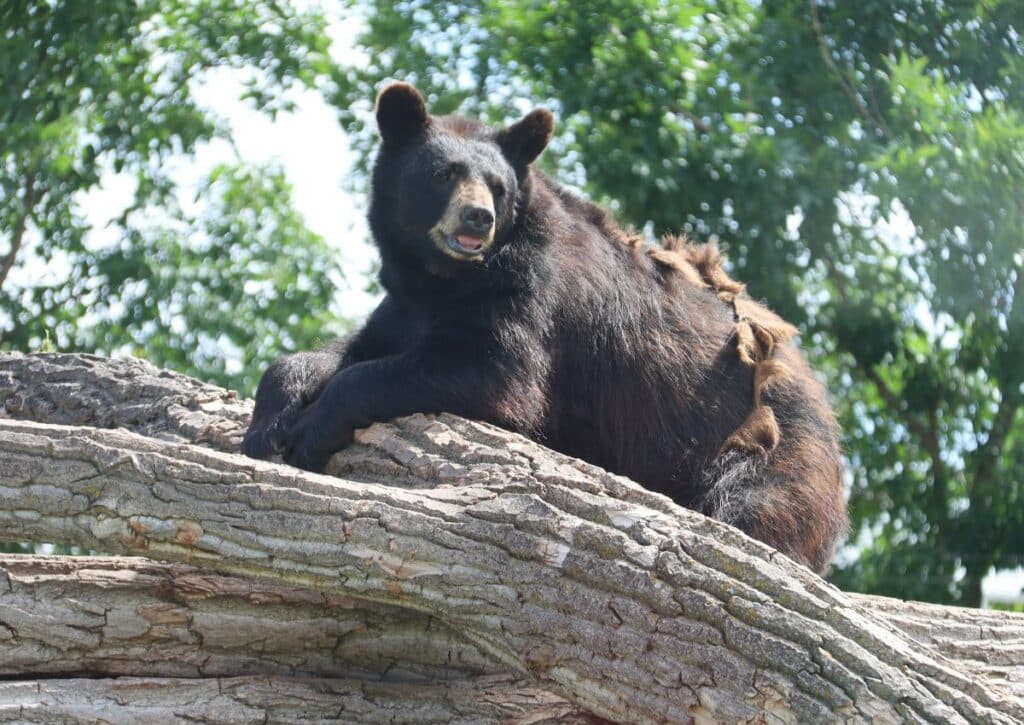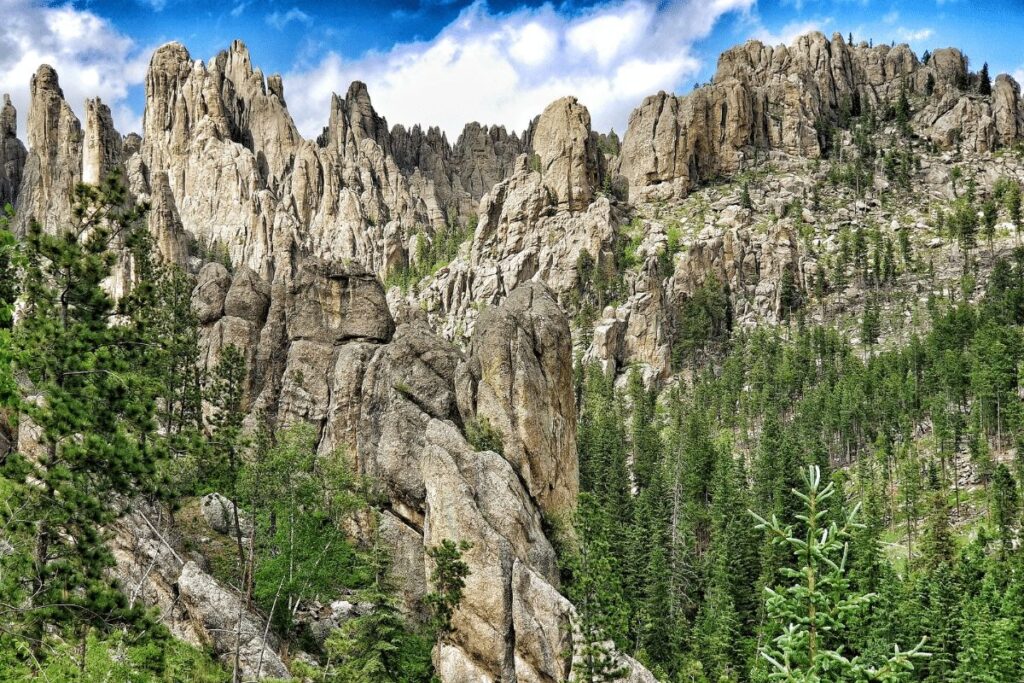Discover 12 Animals in South Dakota's Rich Biodiversity. Explore Hotspots & Wildlife Wonders in the State!
South Dakota, often celebrated for its iconic monuments and rolling prairies, holds a lesser-known treasure: its vibrant and diverse wildlife.
From the graceful prance of the pronghorns across vast grasslands to the silent glide of the bald eagle in the cerulean sky, this state is a canvas painted with nature’s most exquisite details.
Whether you’re an avid wildlife enthusiast seeking the thrill of spotting a stealthy mountain lion or a casual traveler hoping to witness the grandeur of bison herds, South Dakota offers an unparalleled experience.
This journey through the wild heart of the American West promises not just sightings but memories that resonate with the raw, unfiltered beauty of nature. Dive in, and let the adventure in South Dakota’s wilderness begin!
Overview of South Dakota’s Rich Biodiversity
Nestled in the heart of the American Midwest, South Dakota stands as a testament to the incredible biodiversity of the region. .
With a landscape that shifts from the vast expanse of the Great Plains in the east to the rugged terrain of the Black Hills and Badlands in the west, the state provides a diverse range of habitats catering to an array of wildlife.
The vast grasslands, home to iconic American bison and swift pronghorns, are punctuated with patches of wetlands, drawing a myriad of bird species, from migratory waterfowl to native songbirds.
The dense coniferous forests of the Black Hills serve as a refuge for elusive predators like the mountain lion and provide nesting grounds for majestic bald eagles.
The Badlands, with their striking geological formations, harbor specialized species adapted to its unique environment, including bighorn sheep and the endangered black-footed ferret.
Furthermore, the numerous rivers and lakes of South Dakota teem with freshwater life, offering a vibrant aquatic ecosystem. From fish to amphibians, the waters reflect the state’s richness.
South Dakota’s biodiversity is a testament to the delicate balance of nature and the intricate web of life, showcasing the profound interconnectedness of species across varied landscapes.
The Bison
The bison, often referred to as the American buffalo, is an iconic symbol of the vast open plains of North America.
With a massive head, strong shoulders, and a shaggy brown coat, they are built for life in the harsh environments of the prairies.
Their adult size can range from 7 to 11.5 feet in length and 5 to 6.5 feet tall at the shoulder, with males typically weighing up to 2,200 pounds and females up to 1,100 pounds.
Custer State Park is perhaps the most famous destination in South Dakota to witness vast herds of bison. Here, they can be seen roaming freely across the expansive grasslands, often causing delightful “bison jams” on park roads.
Additionally, Wind Cave National Park and the surrounding Black Hills region also offer glimpses of these majestic animals. Buffalo Gap National Grassland also offers amazing sightings.
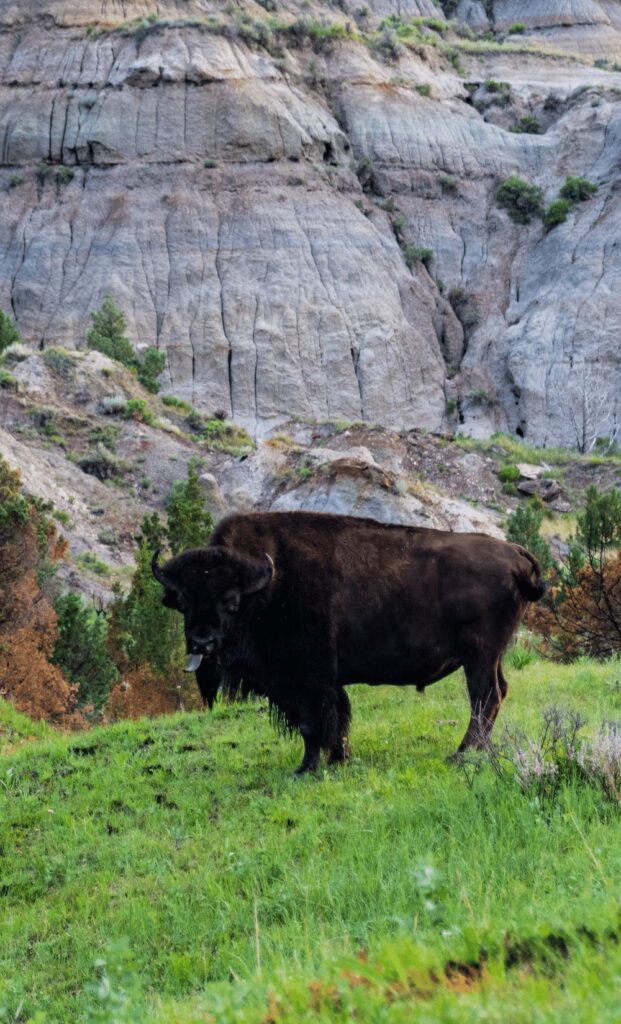
Historical Abundance: Once numbering in the tens of millions across North America, bison faced near-extinction due to hunting and habitat loss in the late 19th century.
Conservation efforts in the 20th century, however, have brought their numbers back to several hundred thousand.
Rut Season: During the late summer, male bison engage in fierce battles for mating rights. These intense contests involve charging and butting heads with tremendous force.
Versatility: Bison have adapted to survive in extreme weather conditions, from the hot summers to the freezing winters of the American plains. Their thick coat not only provides insulation but also sheds to allow comfort during warmer months.
Ecological Importance: Bison play a crucial role in maintaining the health of grassland ecosystems. Their grazing patterns promote biodiversity, allowing various grass species to thrive, and their wallowing creates depressions that can hold water, benefitting other wildlife.
The Pronghorn
Pronghorns are striking creatures, often recognized by their tan-brown bodies contrasted with white markings on the face, neck, chest, and belly.
Males and females both possess horns, though the males’ are typically longer, reaching up to 12 inches.
Unlike other antlered or horned mammals, the pronghorn’s horn is unique; it consists of a keratin sheath that is shed and regrown annually over a bony core.
Their large eyes, set on the sides of their head, give them a nearly 360-degree field of vision, essential for spotting predators in open landscapes.
Pronghorns are commonly seen grazing on the grasslands of South Dakota. Custer State Park, Badlands National Park, and Fort Pierre National Grassland are among the best places to observe these fleet-footed animals in their natural habitat.
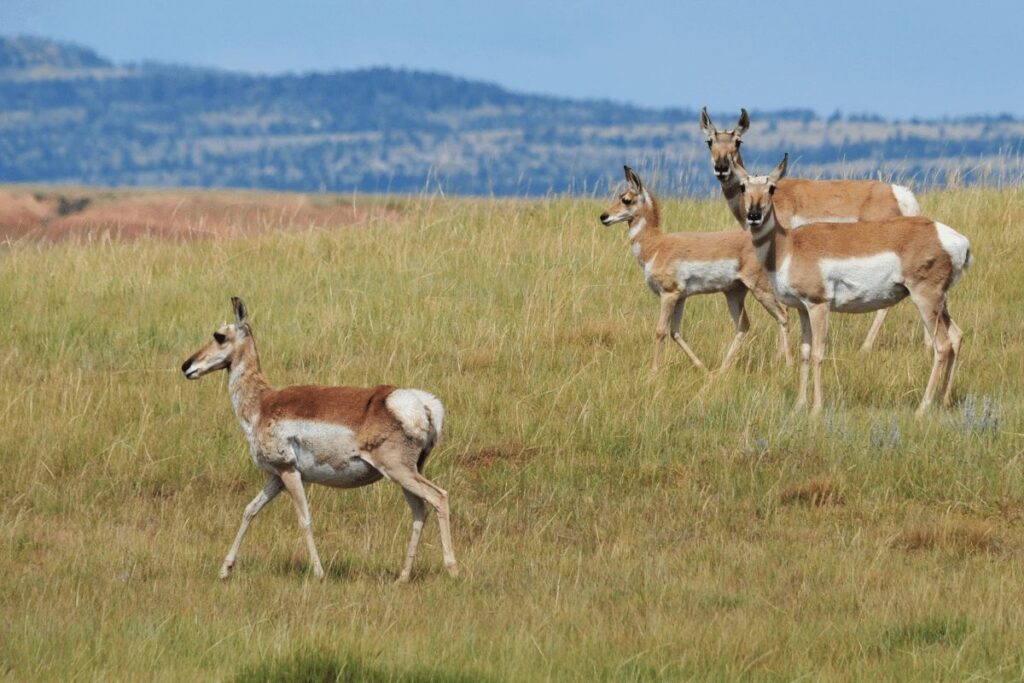
Speed Demons: Pronghorns are the second-fastest land mammal on earth, just behind the cheetah.
They can reach speeds of up to 55 mph and maintain a speed of 30 mph for over 20 miles, making them North America’s speed champions.
Evolutionary Puzzle: It’s believed that pronghorns evolved their remarkable speed to escape now-extinct predators that once roamed North America, as none of the continent’s current predators can match their top speeds.
Migration: Some pronghorn populations undertake long migrations, traveling hundreds of miles between their summer and winter ranges, making them one of North America’s great migratory species.
Diverse Diet: While pronghorns primarily graze on grasses, they have a varied diet that includes forbs, shrubs, and cacti, allowing them to survive in the diverse terrains of South Dakota.
The Coyote
Coyotes sport a slender, streamlined body covered in a thick fur that varies in color from grayish-brown to yellow-gray, with patches of white on the belly and throat.
Their pointed ears, sharp snout, and bushy tail with a black tip are characteristic features. Adult coyotes typically weigh between 20 to 50 pounds and stand about 1.5 to 2 feet tall at the shoulder.
Coyotes are incredibly adaptable and can be found throughout South Dakota, from the prairies of Fort Pierre National Grassland to the forests of the Black Hills. They can also be found in the Buffalo Gap National Grassland.
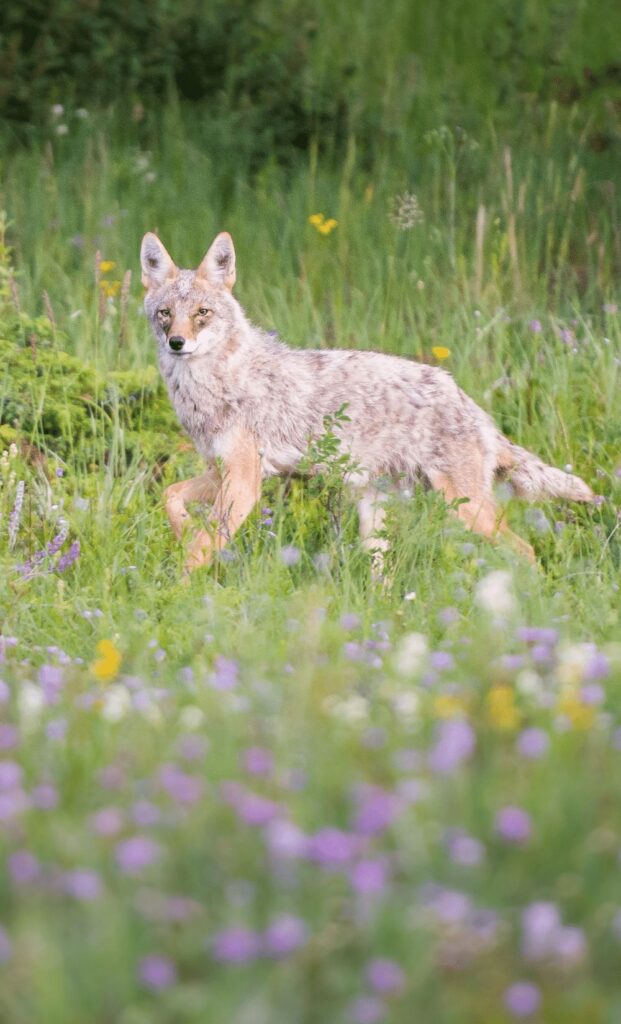
They’re most active during the early morning or late evening hours.
Versatile Diet: Coyotes are omnivores with a diet that includes rodents, rabbits, fruit, vegetables, and even insects, showcasing their adaptability to various habitats.
Vocal Creatures: Known for their haunting howls, coyotes communicate using a range of vocalizations, including yips, barks, and howls, often heard during dawn or dusk.
Clever Survivors: As territories of larger predators like wolves have dwindled, coyotes have expanded their range across North America, showcasing their resilience and adaptability.
Family Units: Coyotes often form family groups, especially when raising their young, working together to hunt and protect their territory.
The White-tailed Deer
The white-tailed deer is a medium-sized deer known for its brown coat that turns grayish in the winter. It derives its name from the fluffy white underside of its tail, which it raises as a warning signal to other deer.
Males, known as bucks, grow impressive antlers annually, which they shed in the winter. Adults typically weigh between 100 to 300 pounds.
White-tailed deer are widespread throughout South Dakota. They can be found in a variety of habitats including forests, grasslands, and even urban areas. Notable locations to observe them include the Black Hills National Forest, Custer State Park, and Sica Hollow State Park.
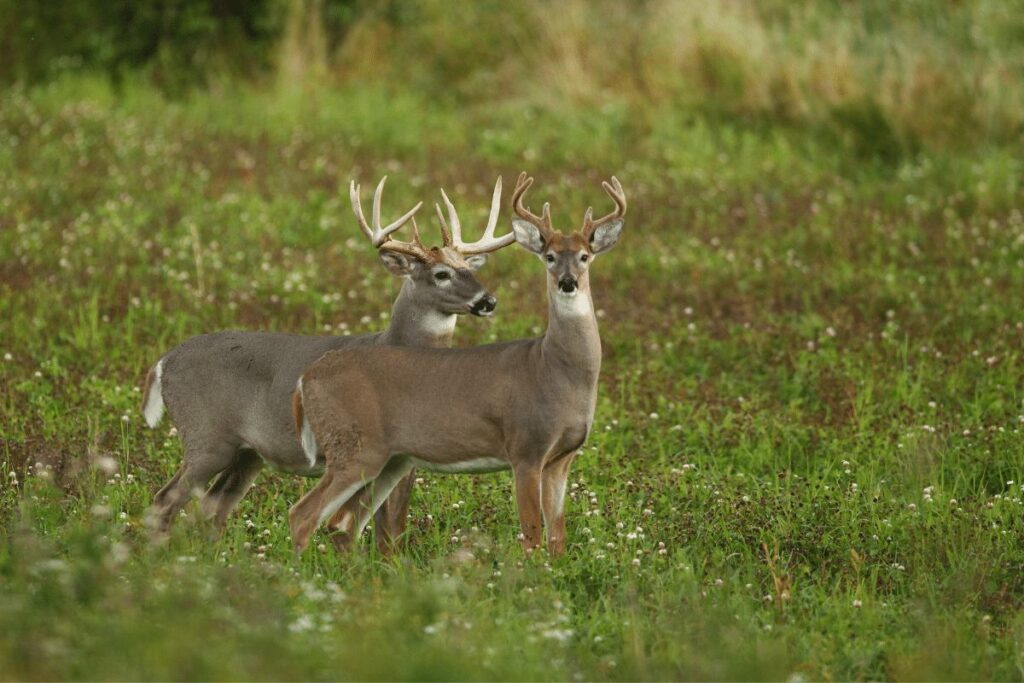
Seasonal Antlers: The antlers of male white-tailed deer grow in the spring and are shed in the winter. They are used during the fall rutting season for display and battles with other bucks.
Twilight Feeders: White-tailed deer are crepuscular, meaning they’re most active during the dawn and dusk hours, often seen grazing during these times.
Alert Jumpers: When threatened, white-tailed deer exhibit a unique bounding leap, called “stotting,” where all four feet leave the ground simultaneously. This can serve as a warning to other deer or an attempt to evade predators.
Social Structures: While bucks can be solitary or form small groups, females (does) and their fawns often form larger groups, offering safety in numbers and aiding in rearing the young.
The Mountain Lion
Also known as cougars, pumas, or panthers, mountain lions are powerful and graceful big cats.
They have a slender body covered in a smooth, unmarked coat that ranges from a tawny to grayish color, with a white underbelly.
Their heads are round with erect ears, and they possess strong limbs with retractable claws. A distinguishing feature is their long, thick tail, often with a black tip, which aids in balance.
Adult mountain lions typically weigh between 80 to 200 pounds, with males being larger than females.
The Black Hills region of South Dakota is a primary habitat for mountain lions in the state. This rugged and forested terrain provides the perfect backdrop for these elusive cats.

Sightings can be rare due to their secretive nature, but places like the Black Hills National Forest and Wind Cave National Park offer potential opportunities for the keen observer.
Masters of Stealth: Mountain lions are solitary and territorial predators.
They rely on stealth and strength to hunt, often ambushing their prey from behind and delivering a fatal bite to the neck.
Diverse Diet: While deer is a primary food source, mountain lions have a varied diet that includes smaller mammals, birds, and even insects, showcasing their adaptability to diverse habitats.
Acrobatic Abilities: Known for their powerful limbs, mountain lions are excellent climbers and swimmers.
They can make vertical leaps of up to 15 feet and horizontal leaps of 40 feet.
Vocalizations: Despite being big cats, mountain lions cannot roar. Instead, they communicate through purrs, hisses, growls, and other vocalizations.
They also use scent markings to define their territory and communicate with potential mates.
The Badger
Badgers are stout, burly mammals with a broad body, short legs, and a flat head. Their fur is grizzled gray on the top with distinct black and white stripes on the face, extending from the nose to the back of the head.
They have powerful, clawed front feet, ideal for digging. Adult badgers typically weigh between 12 to 24 pounds and have a body length of around 20 to 34 inches.
Badgers can be found throughout South Dakota, especially in areas with sandy or loamy soil suitable for digging.
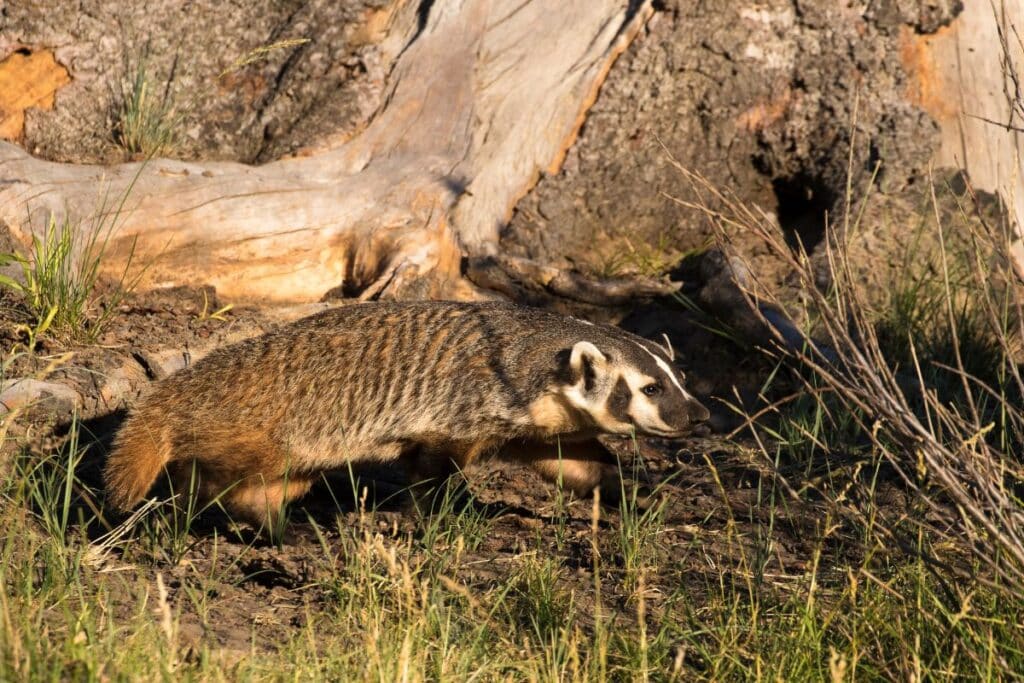
They inhabit grasslands, open fields, and the edges of forests. Places like the Fort Pierre National Grassland, Buffalo Gap and Badlands National Park are among the best spots to potentially spot these elusive diggers.
Digging Experts: Badgers are renowned for their burrowing skills, creating extensive underground homes with multiple chambers and exits.
Night Owls: Badgers are primarily nocturnal, hunting for their prey, which includes rodents, insects, and reptiles, under the cover of darkness.
Solitary by Nature: Outside of the breeding season, badgers prefer a solitary existence, defending their territory fiercely against intruders.
Mutualistic Relationship: In some regions, badgers have been observed hunting in tandem with coyotes.
While badgers dig out prey, the coyotes catch the ones trying to escape, benefiting both predators.
The Mule Deer
Mule deer, named for their large, mule-like ears, are robust deer with a grayish-brown coat.
Their tail is black-tipped, and their face is lighter in color than the rest of their body. Bucks possess forked antlers that they shed and regrow annually.
Adult mule deer weigh between 130 to 280 pounds for males and 95 to 200 pounds for females.
Mule deer are widespread across western South Dakota, preferring the brushy foothills and open woodlands.
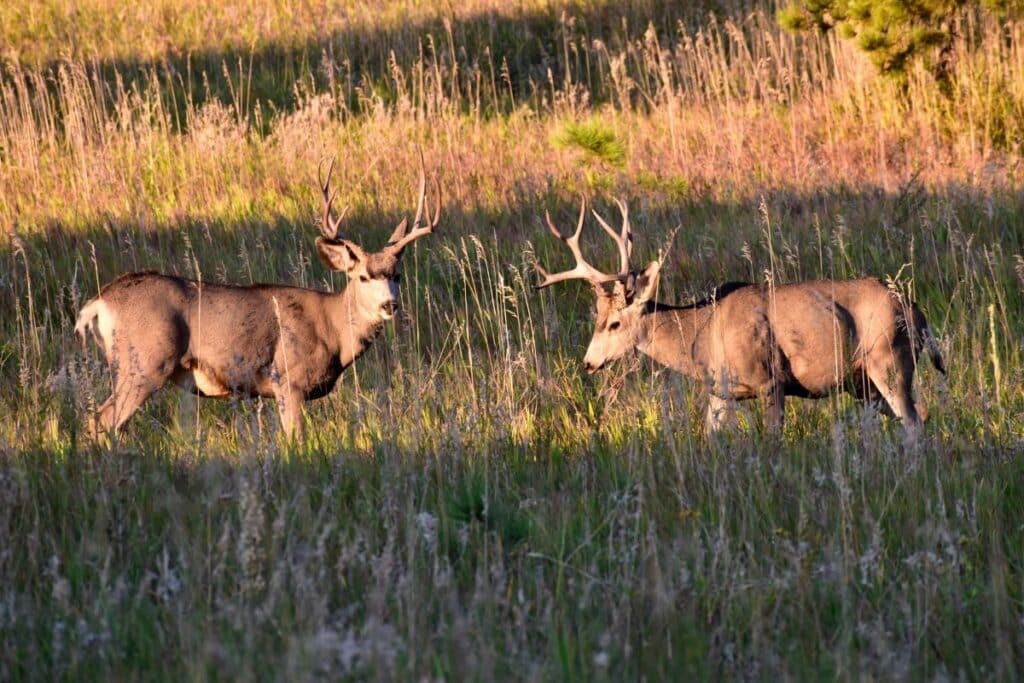
The Black Hills National Forest, Badlands National Park, and Custer State Park are excellent locations to observe these deer in their natural habitat.
Unique Gait: Unlike their white-tailed relatives, mule deer have a distinctive bounding leap, known as “stotting,” where all four legs push off the ground simultaneously.
Adaptable Foragers: Mule deer are browsers, feeding on a wide variety of vegetation including shrubs, grasses, and cacti, allowing them to adapt to different environments.
Seasonal Migrations: Some populations of mule deer are migratory, moving between summer and winter ranges to find food and avoid deep snow.
Safety in Numbers: While mule deer can be solitary, especially the bucks, females often form groups, particularly during fawning season, to provide collective vigilance against predators.
The Bighorn Sheep
Bighorn sheep are robust, sure-footed mammals renowned for the large, spiral horns of the males, or rams.
These horns can weigh up to 30 pounds and measure over 3 feet in length. Females, or ewes, also have horns, but they are shorter and less curved.
Bighorn sheep have a brown coat with a white belly, rump, and muzzle.
Adult rams typically weigh between 160 to 300 pounds, while ewes weigh between 75 to 200 pounds.
Badlands National Park is a prime location to observe bighorn sheep in South Dakota. The rugged terrain provides an excellent backdrop as these animals navigate steep cliffs and rocky outcrops with surprising agility.
Another place we have always seen bighorn sheep is Buffalo Gap.
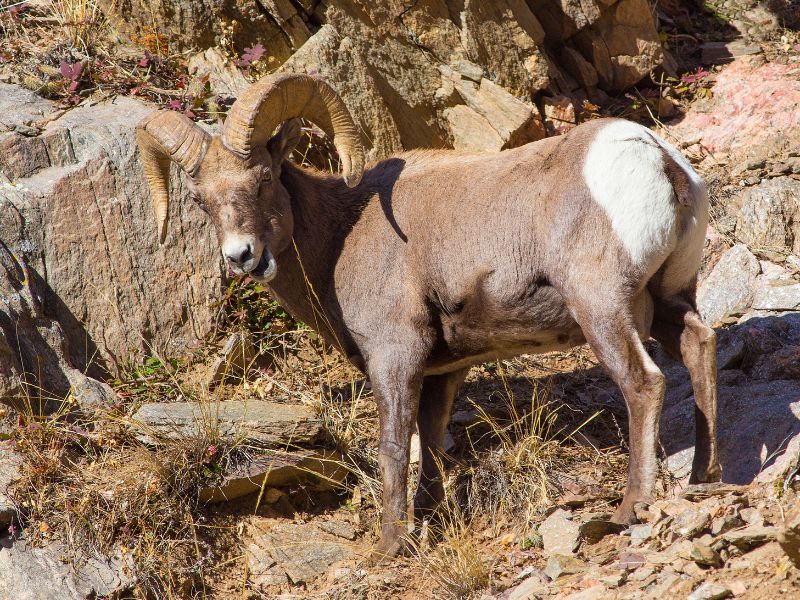
Headbutting Battles: During the mating season, male bighorn sheep engage in headbutting contests to establish dominance and secure mating rights.
The sound of their horns clashing can be heard miles away.
Mountain Climbers: Their hooves have a specialized, concave shape that provides a natural grip, making them adept climbers capable of navigating nearly vertical terrains.
Herbivore Diet: Bighorn sheep primarily graze on grasses, but they also consume a variety of plants, shrubs, and even lichen when food is scarce.
Visionary Skills: Their excellent vision helps them spot predators from afar and navigate the rugged landscapes they call home.
The Black-footed Ferret
The black-footed ferret is a slender, elongated carnivore with a yellowish-brown body and distinctive dark markings on its feet, tail tip, and a mask-like pattern on its face.
Adults typically measure 18 to 24 inches in length and weigh between 1.5 to 2.5 pounds.
The Conata Basin area in Badlands National Park has been a key site for black-footed ferret reintroduction efforts.
Spotting these nocturnal creatures can be challenging, but night tours in the park offer the best opportunity to catch a glimpse.
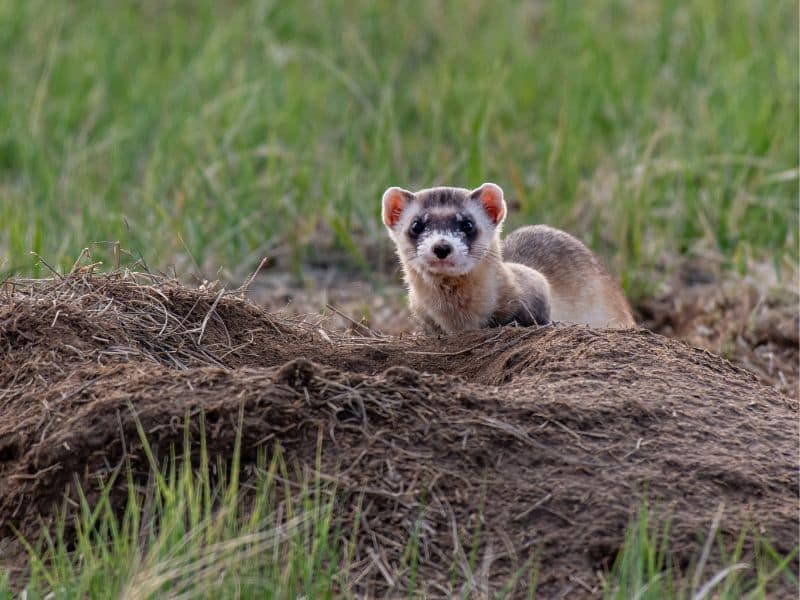
Prairie Dog Predators: Black-footed ferrets primarily feed on prairie dogs, which comprise over 90% of their diet. They also use abandoned prairie dog burrows for shelter and raising their young.
Endangered Species: Once thought to be extinct in the wild, the black-footed ferret is one of North America’s most endangered mammals. Conservation and reintroduction efforts have been critical in preventing their complete disappearance.
Nighttime Hunters: Being nocturnal, black-footed ferrets hunt during the night, relying on their keen sense of smell and sharp vision to locate prey.
Distinctive Dance: When excited or playful, these ferrets perform a unique “weasel war dance,” which involves hopping, spinning, and making chattering noises.
The Bald Eagle
The bald eagle, America’s national symbol, is a majestic bird of prey known for its striking appearance.
Adult bald eagles boast a dark brown body and wings contrasted with a white head and tail.
Their yellow beak, feet, and eyes stand out against their white and brown plumage. They possess a wingspan that can exceed 7 feet, making them one of the largest raptors in North America.
Adult bald eagles typically weigh between 6.5 to 14 pounds, with females being larger than males.
Bald eagles can be found throughout South Dakota, particularly near large bodies of water like the Missouri River, Lake Oahe, and Lake Sharpe.
During winter, they can often be seen perched in tall trees along waterways, scouting for fish or waterfowl.
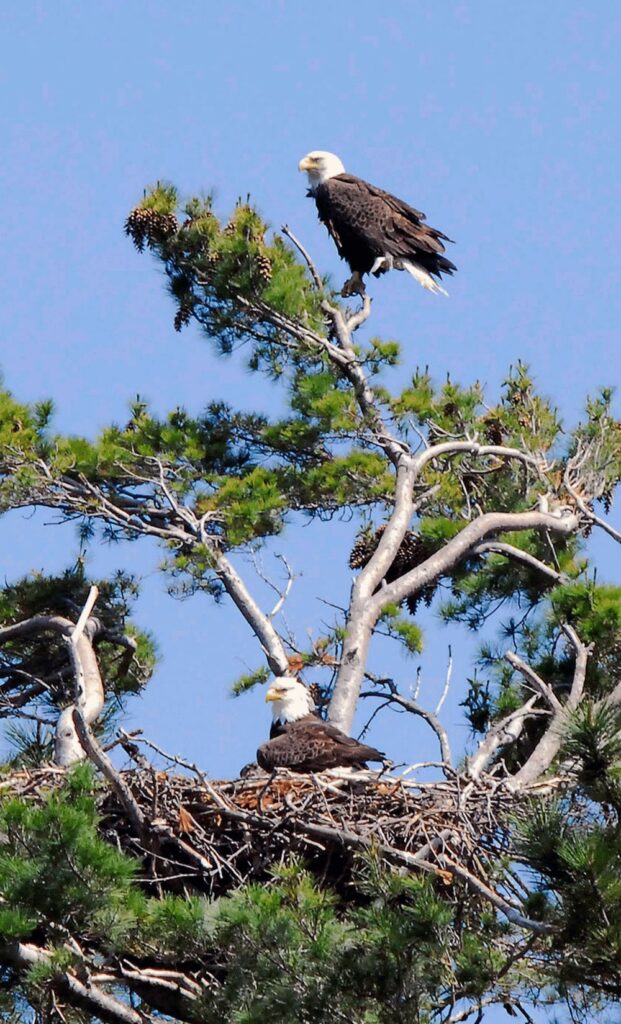
The Missouri National Recreational River and Bear Butte State Park are just a couple of the prime spots to observe these magnificent birds.
Master Fishers: Bald eagles primarily feed on fish, which they snatch from the water with their powerful talons.
Their exceptional vision allows them to spot potential prey from great distances.
Lifelong Partners: Once they find a mate, bald eagles often pair for life. Together, they build large nests, some of which can weigh over a ton, and return to the same nesting sites year after year.
Symbol of Freedom: Adopted as the national emblem of the United States in 1782, the bald eagle represents freedom and strength.
Conservation Success: Once endangered due to hunting, habitat loss, and the effects of the pesticide DDT, bald eagles have made a remarkable comeback thanks to conservation efforts.
Their recovery is often hailed as one of the significant success stories in wildlife conservation.
The Wild Turkey
The wild turkey is a large, ground-dwelling bird with a fan-shaped tail, a small head, and a long neck.
Males, known as toms or gobblers, are more colorful than females, sporting iridescent bronze and green feathers with hints of red, purple, and gold.
They also have a beard-like cluster of hair-like feathers hanging from their chest. Females, or hens, are generally browner and lack the vibrant sheen.
Adult wild turkeys typically weigh between 5 to 24 pounds, with males being considerably larger than females.
Wild turkeys are widespread throughout South Dakota, populating wooded areas, grasslands, and even suburban locales.
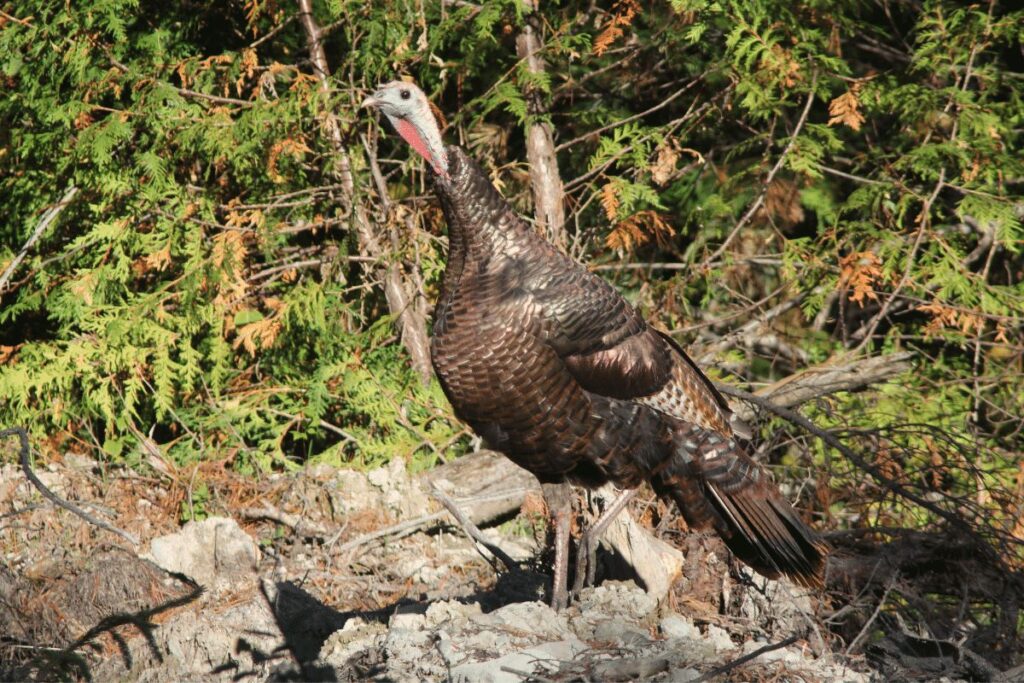
The Black Hills region, in particular, is a hotspot for wild turkey sightings.
Custer State Park, Spearfish Canyon, and the Missouri River Valley are prime locations to observe these birds.
Vocal Communicators: Wild turkeys are known for their gobbling calls, especially during the breeding season.
However, they produce a range of sounds, from clucks to purrs, to communicate with each other.
Impressive Flyers: Contrary to some beliefs, wild turkeys are strong flyers, albeit over short distances.
They can reach speeds up to 55 miles per hour in flight, usually opting to fly to their roosting trees at night.
Varied Diet: While they primarily forage on the ground for nuts, seeds, fruits, and small insects, wild turkeys are known to eat a diverse range of foods, adapting to what’s available seasonally.
Protective Mothers: After laying eggs, hens become very secretive, hiding their nests under thick vegetation.
Once the chicks (poults) hatch, the mother fiercely protects them, teaching them to feed and navigate the wild.
The Bobcat
Bobcats are medium-sized wildcats distinguished by their tufted ears, ruffed face, and short “bobbed” tail, which has a few dark bands and a black tip on top.
Their coat varies from light gray or brown to reddish-brown with faint spotting, allowing them to blend seamlessly into their environment.
Typically, bobcats weigh between 15 to 30 pounds, with males being larger than females. Their muscular bodies and strong limbs make them adept hunters.
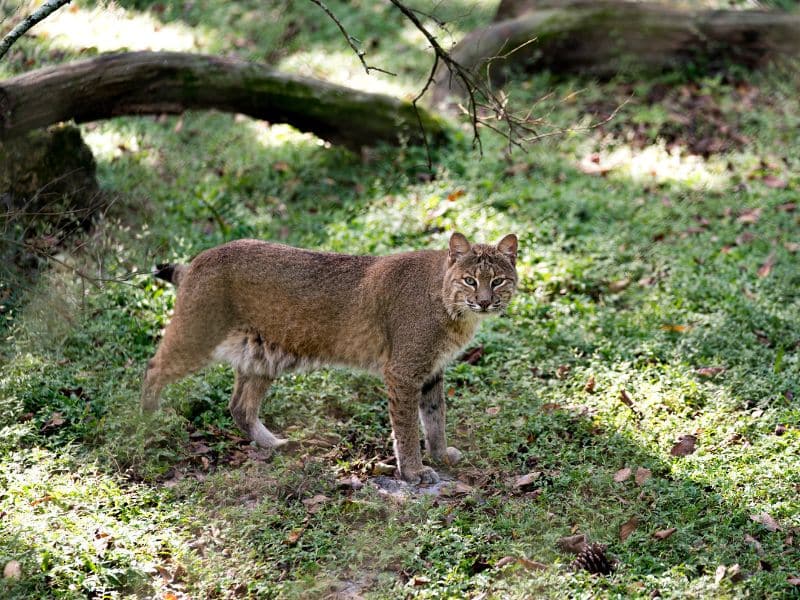
Bobcats can be found across South Dakota, from the dense forests of the Black Hills to the grasslands and riverine habitats in the eastern part of the state.
While they are elusive and primarily nocturnal, areas like the Black Hills National Forest, Wind Cave National Park, and Sica Hollow State Park are among the places where one might catch a rare glimpse of this secretive feline.
Versatile Diet: Bobcats are opportunistic predators, feeding on a variety of prey, from rabbits and rodents to birds and even deer.
Their diet shifts based on what’s available in their environment.
Silent Stalkers: Bobcats are masters of stealth. They use their keen senses of sight and hearing to stalk and ambush prey, often delivering a swift and powerful pounce.
Territorial Creatures: Bobcats are solitary animals that mark and defend their territory with scent markings.
These territories can range from 1 to over 30 square miles, depending on the availability of food.
Adaptable Survivors: Bobcats have shown a remarkable ability to adapt to various habitats, from forests and mountains to suburban areas.
This adaptability has allowed them to remain widespread even as many other wildcat species face threats.
12 Places to See Wildlife in South Dakota (Top Spots Included)
South Dakota, with its diverse landscapes ranging from vast grasslands to dense forests and rugged badlands, offers a rich tapestry of wildlife experiences.
Whether you’re an avid birdwatcher, a wildlife photographer, or just a nature enthusiast, the state provides a myriad of opportunities to witness North America’s most iconic species in their natural habitats.
Dive into our curated list to discover the best places to immerse yourself in South Dakota’s unparalleled wildlife wonders.
Buffalo Gap National Grassland: An Untamed Wilderness
In the southwestern corner of South Dakota, Buffalo Gap National Grassland stretches its vast expanse over 600,000 acres.
It’s a land where the horizon seems endless, showcasing the raw beauty of North America’s open spaces.
Located primarily in Fall River County, it brushes into the territories of Jackson and Pennington counties, placing it just south of the famed Badlands National Park.
The landscape here is a painter’s palette of mixed-grass prairie, punctuated by badlands formations, rugged canyons, and gentle rolling hills.
Every blade of grass, every rock, tells the story of a land sculpted by time and the elements.
For wildlife enthusiasts, Buffalo Gap is a haven. It’s not uncommon to spot the regal bison roaming in herds, or the swift pronghorn darting across the plains.
Majestic bighorn sheep navigate the rugged terrains, while the coyotes’ haunting calls provide a soundtrack to the setting sun.
The skies, vast and clear, are home to golden eagles and myriad bird species, making it a birdwatcher’s paradise.
Among the many trails that crisscross the grassland, the Centennial Trail stands out. It’s a journey through the heart of the grassland, promising awe-inspiring vistas and intimate encounters with the region’s flora and fauna.
The Indian Creek Campground beckons those looking for a night under the stars, enveloped by nature’s silence. For the more adventurous, the trek up to Sheep Mountain Table is a must.
The mesa, though challenging to reach, offers panoramas that are the stuff of legends.
Despite its vastness, Buffalo Gap is surprisingly accessible. It sits just 60 miles away from the bustling city of Rapid City, making it an ideal escape for city dwellers.
Those venturing from the southern city of Hot Springs have a journey of around 100 miles, a small price for the treasures that await.
Custer State Park: A Wildlife Wonderland
Tucked within the Black Hills of South Dakota, Custer State Park covers a sprawling 71,000 acres, making it one of the state’s largest and most beloved parks.
It’s a place where granite peaks kiss the sky, clear streams carve through scenic canyons, and open plains stretch as far as the eye can see.
The park’s wildlife scene is truly unparalleled. It’s home to one of the largest free-roaming bison herds in the country.
These magnificent beasts often graze along the park’s scenic byways, providing visitors with unforgettable up-close encounters.
Other residents include pronghorns, white-tailed deer, mountain goats, and a playful population of burros.
Custer State Park boasts several picturesque drives. The Needles Highway, with its narrow tunnels and spiraled rock formations, and the Wildlife Loop Road, known for its animal sightings, are must-visits.
Sylvan Lake, with its pristine waters and granite backdrop, is a haven for hikers and nature lovers.
Located a mere 40 miles from Rapid City, Custer State Park is easily accessible and serves as a gateway to other Black Hills attractions.
From camping under starlit skies to kayaking in crystalline waters, the park promises a multifaceted experience of South Dakota’s natural beauty.
Badlands National Park: A Rugged Masterpiece
Stretching across 244,000 acres, Badlands National Park is a mesmerizing landscape of layered rock formations, deep canyons, and expansive prairies.
Located in the southwestern part of the state, the park is a testament to the power of natural erosion over millions of years.
Its unique topography supports a diverse range of wildlife. Bison and bighorn sheep roam the open grasslands, while prairie dogs offer amusing displays in their bustling towns.
The park is also a refuge for the endangered black-footed ferret, a nocturnal predator reintroduced to its natural habitat.
Visitors can traverse the Badlands Loop Scenic Byway, a drive that reveals some of the park’s most iconic views.
Hiking trails like the Notch Trail or the Door Trail provide intimate experiences with the park’s geologic wonders. The Ben Reifel Visitor Center offers insightful exhibits on the park’s natural and cultural history.
Situated about 90 miles from Rapid City, Badlands National Park is more than just a visual spectacle. It’s a journey through time, telling tales of ancient seas, subtropical forests, and the evolution of species.
Every visit offers a fresh perspective, making it a cherished gem in South Dakota’s crown of natural attractions.
Wind Cave National Park: A Subterranean Marvel
Nestled amidst the southern Black Hills, Wind Cave National Park boasts one of the longest and most intricate cave systems in the world.
Spanning over 149 miles, the cave is renowned for its unique honeycomb-like calcite formations known as boxwork, as well as delicate frostwork.
Above ground, the park unfolds over a vast expanse of mixed-grass prairie, punctuated by dense ponderosa pine forests.
This diverse habitat is a haven for wildlife. Bison, elk, and pronghorns graze the open meadows, while coyotes and prairie dogs add to the dynamic ecosystem.
Several trails crisscross the park, offering glimpses of its above and below-ground wonders.
The Rankin Ridge trail provides panoramic views, while guided tours lead adventurers into the mysterious depths of Wind Cave. The park’s visitor center delves into the cave’s geological significance and the area’s cultural heritage.
Merely 50 miles from Rapid City, Wind Cave National Park is a blend of subterranean intrigue and surface splendor, presenting visitors with a comprehensive experience of the region’s natural treasures.
Black Hills National Forest: A Verdant Expanse
Stretching over 1.25 million acres, the Black Hills National Forest is a lush sanctuary of rugged landscapes, pristine lakes, and dense forests in western South Dakota.
This vast wilderness is a patchwork of ponderosa pine, aspen groves, and burbling streams.
The forest is teeming with wildlife. It’s not uncommon to spot white-tailed deer darting amidst the trees or hear the distant call of a mountain lion.
The forest’s serene lakes and streams house a variety of fish species, making it a popular spot for anglers.
With over 450 miles of trails, the Black Hills National Forest caters to hikers of all levels. The Harney Peak Trail, leading to the highest point east of the Rockies, promises breathtaking vistas.
The Spearfish Canyon Scenic Byway, with its towering limestone cliffs and cascading waterfalls, is a drive to remember.
Positioned roughly 40 miles from Rapid City, the Black Hills National Forest is more than just a woodland. It’s a sanctuary of tranquillity and natural beauty, beckoning visitors to immerse themselves in the heart of South Dakota’s verdant wilderness.
Bear Butte State Park: Sacred Mountain and Wildlife Refuge
Perched on the northern plains near Sturgis, Bear Butte State Park is a unique geological and spiritual landmark.
The park centers around Bear Butte, an ancient volcanic formation rising dramatically from the surrounding landscape.
Sacred to many Indigenous tribes, it’s a place of pilgrimage and prayer.
The park’s varied habitat, from grasslands to deciduous forests, supports a diverse range of wildlife. White-tailed deer, mule deer, and pronghorns are common sights. Bird enthusiasts might spot eagles soaring above or hear the calls of myriad songbirds.
Several trails snake around the park, with the Bear Butte Summit Trail leading to the mountain’s peak, offering panoramic views of the expansive plains.
Only about 25 miles from Rapid City, Bear Butte State Park serves as a sanctuary for both wildlife and those seeking spiritual solace.
Sica Hollow State Park: A Place of Mystery and Natural Beauty
Located in the northeastern corner of South Dakota, Sica Hollow State Park is steeped in both natural beauty and Native American legends.
The park’s name, “Sica,” meaning “bad” or “evil,” reflects tales of mysterious occurrences and eerie phenomena.
Dense forests, sparkling streams, and vibrant wetlands paint a picturesque setting, home to a variety of wildlife. Foxes, raccoons, and white-tailed deer are often spotted amidst the park’s verdant landscapes.
A network of trails provides visitors with a chance to explore the park’s mysteries.
The Trail of Spirits, with interpretive signs detailing the legends, is a popular choice.
About 130 miles from Sioux Falls, Sica Hollow State Park invites visitors to delve into its tales and natural wonders.
Newton Hills State Park: Dense Forests and Birdwatching Haven
Tucked in the southeastern part of the state, Newton Hills State Park is a gem of dense hardwood forests, rolling hills, and clear blue lakes.
Born from glacial activity millennia ago, it’s a haven for nature enthusiasts.
Birdwatchers flock to Newton Hills for its diverse avian population.
Over 200 bird species, including various warblers, woodpeckers, and hawks, have been documented here.
Mammalian residents like red foxes, coyotes, and beavers add to the park’s vibrant biodiversity.
Hiking trails, like the Sergeant Creek Trail, offer immersive experiences of the park’s lush scenery. Canoeing and fishing are popular lake activities.
Just 50 miles from Sioux Falls, Newton Hills State Park is a refreshing escape into the serene embrace of nature.
Newton Hills State Park: A Verdant Retreat
Nestled in the southeastern reaches of South Dakota, not far from Canton, lies Newton Hills State Park, a pristine expanse of rolling hills and dense woodlands.
Its landscapes, sculpted by ancient glacial activity, stand out amidst the predominantly flat terrain of the region, offering a refreshing contrast.
The park is a testament to nature’s resilience and diversity. The forests are a blend of oak, maple, and basswood trees, their canopies providing shelter to a rich tapestry of wildlife. Deer and wild turkeys are frequently spotted, while the park’s lakes and ponds ripple with activity from various fish species, including bass and catfish.
For bird enthusiasts, Newton Hills is a treasure trove. Over 200 bird species, from melodious warblers to majestic hawks, have been recorded within its confines.
The park is particularly renowned for its spring and fall migrations, drawing birdwatchers from all corners.
Hikers have a plethora of trails to choose from. The Sergeant Creek Trail, with its serene lake views and gentle slopes, is a favorite among many.
For those looking to stay overnight, the park boasts well-equipped campsites, some overlooking the tranquil waters of Lake Lakota.
Situated about 50 miles from Sioux Falls, Newton Hills State Park is more than just a natural reserve. It’s a reminder of the beauty that lies in untouched landscapes, where nature thrives and serenity reigns.
Whether it’s for birdwatching, hiking, or simply a picnic by the lake, the park welcomes visitors to immerse themselves in its captivating charm.
Sand Lake National Wildlife Refuge: A Birdwatcher’s Paradise
Located in the northeastern part of South Dakota, near the town of Aberdeen, Sand Lake National Wildlife Refuge is a spectacular haven for migratory waterfowl and other avian species.
Established in 1935, the refuge covers over 21,000 acres, primarily consisting of wetlands, marshes, and grasslands. It’s a crucial stopover for birds during their migration, making it a pivotal part of the Central Flyway.
The shimmering waters of Sand Lake and its surrounding marshlands serve as the heart of the refuge. Here, thousands of ducks, geese, and swans gather, particularly in the spring and fall.
Their symphonic calls during peak migration times create a natural orchestra that echoes across the landscape.
Beyond waterfowl, the refuge is home to a rich diversity of bird species. Majestic bald eagles, elusive herons, and vibrant songbirds can often be spotted. The tall grasslands, on the other hand, provide shelter for white-tailed deer, foxes, and coyotes.
For those keen to explore, the refuge offers an auto tour route that takes visitors through its diverse habitats.
The observation towers and platforms strategically placed throughout the area provide panoramic views and excellent photography opportunities.
Just a 30-minute drive from Aberdeen, Sand Lake National Wildlife Refuge stands as a testament to nature’s wonders.
It’s a place where the sky is painted with the wings of thousands, and the air resonates with the melodies of the wild.
For birdwatchers, nature enthusiasts, and photographers alike, the refuge offers a glimpse into the unbridled beauty of South Dakota’s wetland ecosystems.
Fort Pierre National Grassland: A Sea of Grasses
Draped over central South Dakota, south of the Missouri River, lies the Fort Pierre National Grassland.
Encompassing over 115,000 acres, this expansive landscape is a sea of waving grasses, punctuated by rugged badlands and scattered wetlands.
Unlike dense forests or towering mountains, grasslands possess a subtle beauty that speaks of vastness, resilience, and continuity.
Wildlife thrives amidst the mixed-grass prairie of Fort Pierre. Bison, once nearly extinct but now reintroduced, graze alongside pronghorns and mule deer.
Birds of prey, such as hawks and eagles, ride the thermals overhead, while burrowing animals like prairie dogs create bustling communities below.
While the grassland might seem uniform at first glance, it offers a variety of recreational activities.
From hunting and camping to birdwatching and hiking, visitors have ample opportunities to engage with nature.
Moreover, its location, around 20 miles from Pierre, South Dakota’s capital, makes it easily accessible for both day-trippers and long-term explorers.
LaCreek National Wildlife Refuge: Wetland Wonders
Tucked in the southern edge of South Dakota, near the border with Nebraska, LaCreek National Wildlife Refuge is a vital sanctuary for waterfowl and numerous other species.
The refuge covers approximately 16,400 acres, a mosaic of ponds, marshes, and grasslands that provide a nurturing environment for a myriad of creatures.
The water bodies of LaCreek are particularly notable for their large populations of migratory birds. In the spring and autumn, it’s not uncommon to witness large congregations of ducks, geese, and even the elegant American white pelican.
The refuge also offers shelter to threatened species, most notably the bald eagle and the piping plover.
A combination of marked trails and observation platforms ensures that visitors get the most out of their time at LaCreek.
Whether it’s the mesmerizing sunrises over the wetlands, the gentle calls of the sandhill cranes, or the playful antics of otters in the water, the refuge promises a plethora of unforgettable sights and sounds.
Approximately a two-hour drive from Rapid City, LaCreek National Wildlife Refuge stands as a testament to the importance of preserving natural habitats.
For those willing to venture to this remote corner of South Dakota, the rewards are rich – a serene landscape teeming with life and echoing with stories of the wild.
Ecosystems in South Dakota
South Dakota, with its vast landscapes, showcases an impressive array of ecosystems, each contributing uniquely to the state’s rich biodiversity.
Grasslands: The expansive prairies of South Dakota are emblematic of the Great Plains.
Dominated by species like buffalo grass and blue grama, these mixed-grass prairies are home to a diverse range of fauna, including bison, pronghorns, and prairie dogs.
The wind rustling through the grass and the endless horizon define this iconic ecosystem.
Forests: Primarily found in the Black Hills region, the forests of South Dakota consist of dense stands of ponderosa pine, spruce, and aspen.
These woodlands shelter creatures like white-tailed deer, elk, and mountain lions, offering a stark contrast to the open prairies.
Wetlands: Dotting the eastern part of the state are numerous wetlands, providing essential habitats for waterfowl, amphibians, and aquatic plants.
Places like Sand Lake National Wildlife Refuge exemplify the importance of these ecosystems, with their shimmering waters and teeming birdlife.
Hills: The undulating landscapes of regions like the Black Hills and Coteau des Prairies offer unique habitats.
Rich in minerals and interspersed with meadows, these elevated terrains support a mix of flora and fauna distinct from the surrounding plains.
Together, these ecosystems paint a vibrant picture of South Dakota, illustrating its ecological diversity and emphasizing the importance of conservation for future generations.
The Official Symbols of South Dakota’s Natural Heritage
State Animal: The Coyote
Coyotes, energetic and adaptable, hold the title of South Dakota’s official state animal. Roaming a variety of the state’s landscapes, from the open prairies to dense woodlands, these cunning predators are often seen during dawn or dusk.
With their melodic howls echoing in the night, they’ve become emblematic of South Dakota’s wild spirit.
Visitors to Custer State Park or the Badlands National Park often have the best chance to catch a glimpse of these elusive creatures in their natural habitat.
State Bird: The Ring-necked Pheasant
Distinguished by its vibrant colors and striking patterns, the Ring-necked Pheasant is South Dakota’s official state bird.
Introduced to the state in the early 20th century, these birds have thrived in the state’s grasslands, particularly in areas with tall grasses or near farmlands.
The best spots for birdwatchers or enthusiasts include the James River Valley and areas around Aberdeen.
State Fish: The Walleye
Celebrated as South Dakota’s official state fish, the Walleye is a prized catch for anglers.
Found in abundance in the glacial lakes region and the Missouri River system, this fish is particularly sought after for its delicious taste.
Popular fishing destinations such as Lake Oahe, Lake Sharpe, and Big Stone Lake are among the top spots to catch these agile swimmers.
South Dakota, rich in natural beauty and biodiversity, honors these species as symbols of the state’s ecological and cultural heritage.
Whether you’re an angler, a birdwatcher, or just a nature enthusiast, there’s always an opportunity to encounter these symbols in their authentic environment.
Conclusion: South Dakota – A Wildlife Enthusiast’s Dream
South Dakota, with its sprawling landscapes and diverse ecosystems, is undoubtedly a treasure trove for nature lovers and adventurers alike.
From the majestic bison roaming the plains to the elusive mountain lions in the Black Hills, the state offers a glimpse into the rich tapestry of North American wildlife.
The varied ecosystems, be it the expansive grasslands, dense forests, shimmering wetlands, or rugged hills, provide habitats that sustain this diverse wildlife.
Hunters, too, find a haven in South Dakota. The state’s commitment to sustainable and ethical hunting practices ensures that the age-old traditions continue in harmony with conservation efforts.
Through a comprehensive set of regulations, South Dakota strikes a balance between the thrill of the hunt and the imperatives of wildlife preservation.
For those who tread its trails, peer through binoculars at its birdlife, or simply soak in its natural beauty, South Dakota offers experiences that are both profound and exhilarating.
It’s a reminder of the intricate web of life that we’re all a part of and the responsibilities we bear in preserving it for future generations.
In the end, whether you’re an avid hunter, a birdwatcher, a hiker, or just someone seeking solace in nature, South Dakota beckons with open arms, promising memories that will last a lifetime.

